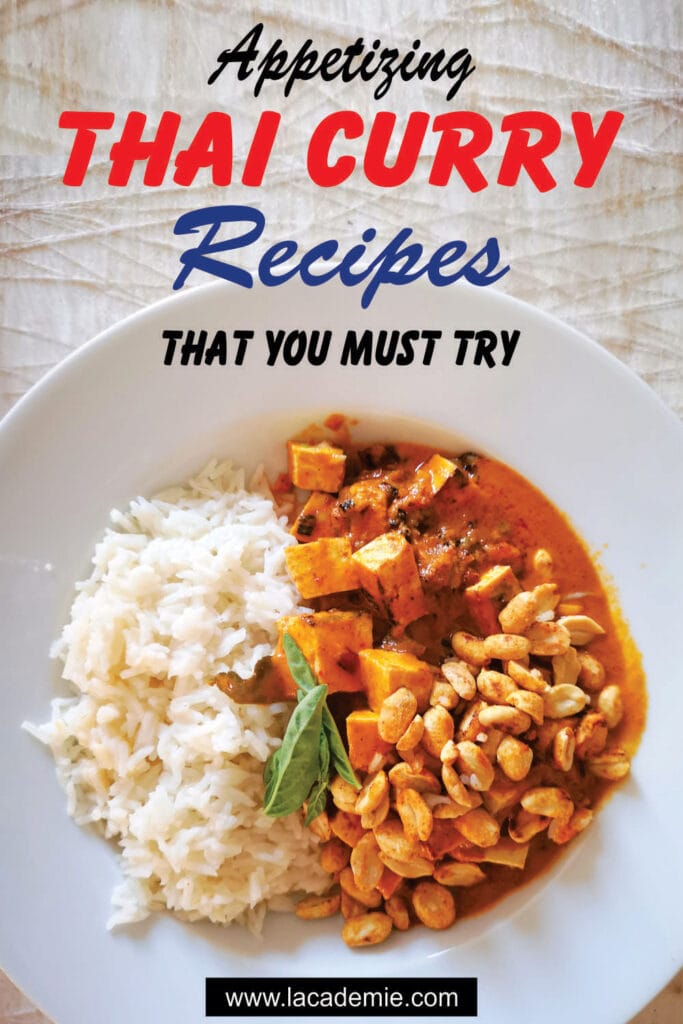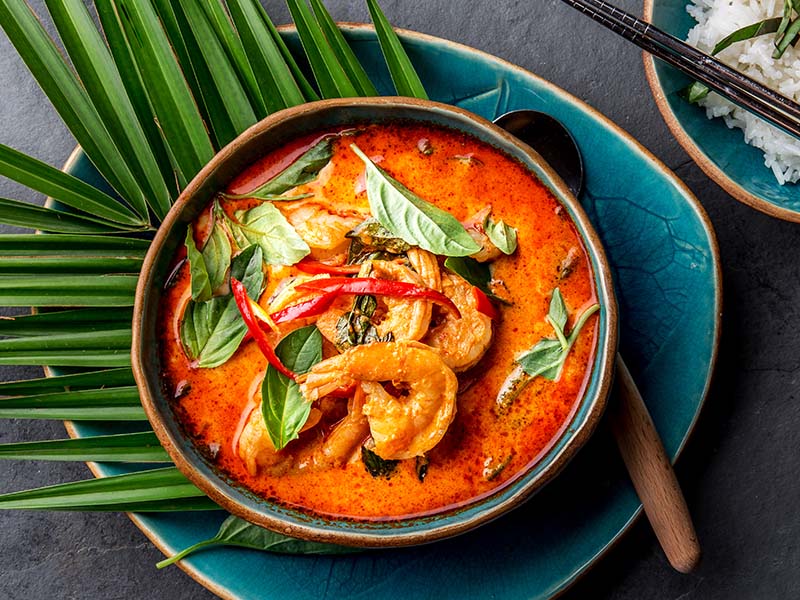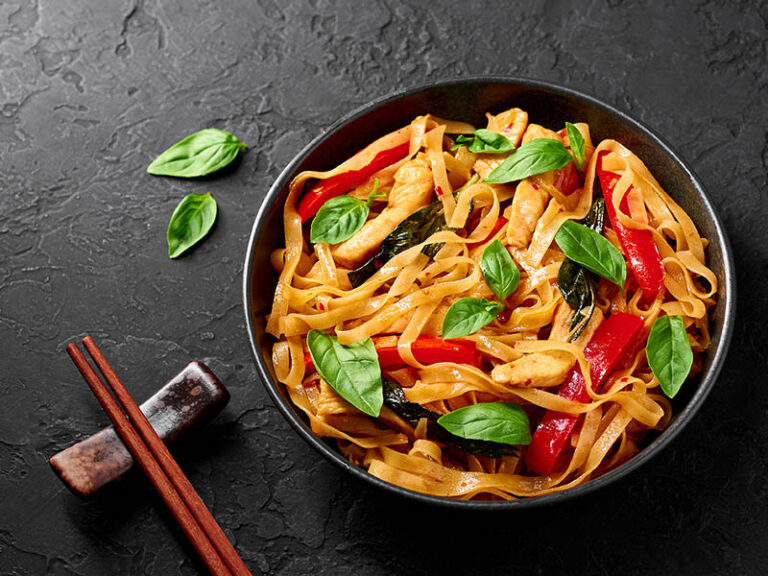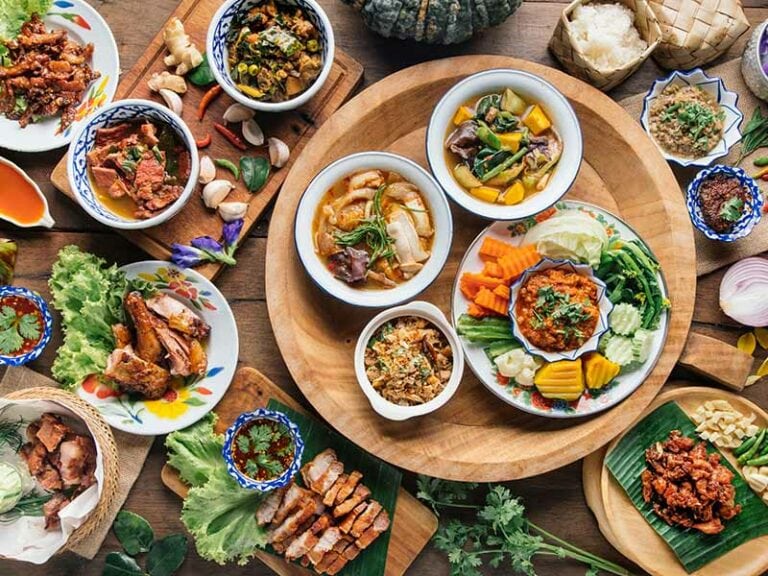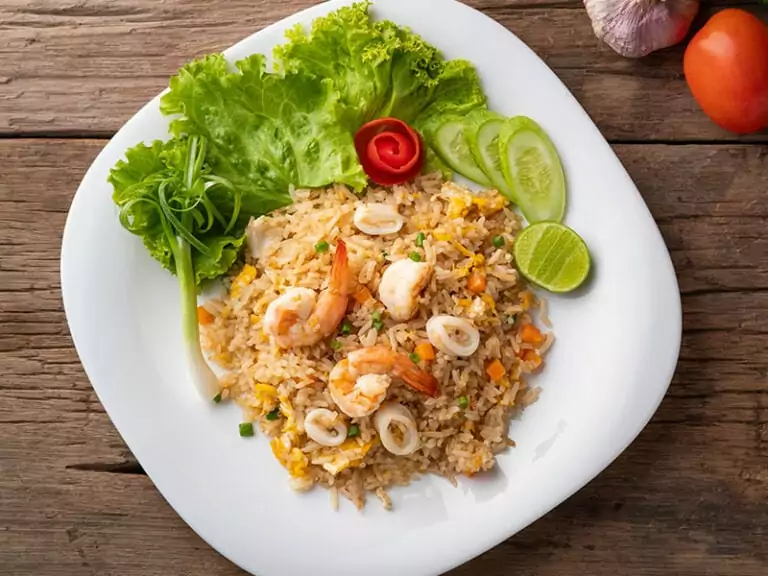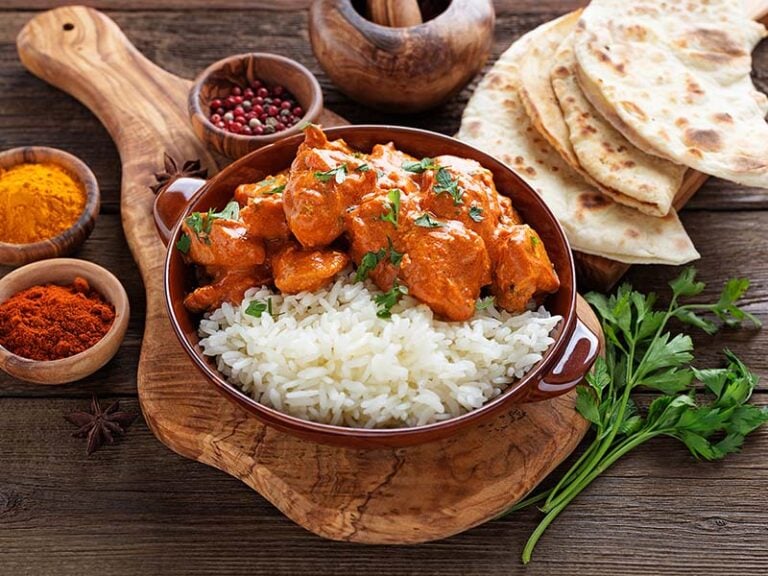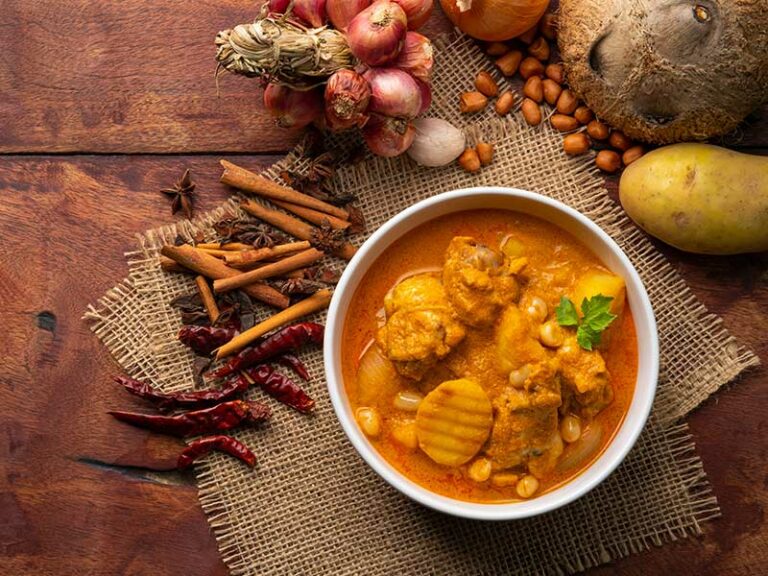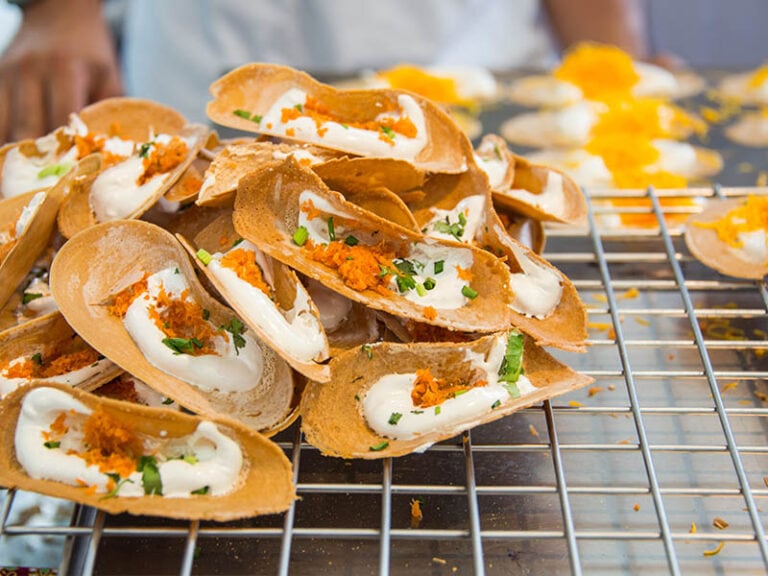When it comes to cuisine, Thai curry recipes are always on top of the most wanted foods in Thailand. So come along with me to uncover vintage Thai delicacies that utilize curry as part of the cooking process.
All you have to do is prepare your mind to get blasted away by the bold and fragrant spices. The nice thing is that these recipes are always simple to materialize in your kitchen by following a couple of simple steps.
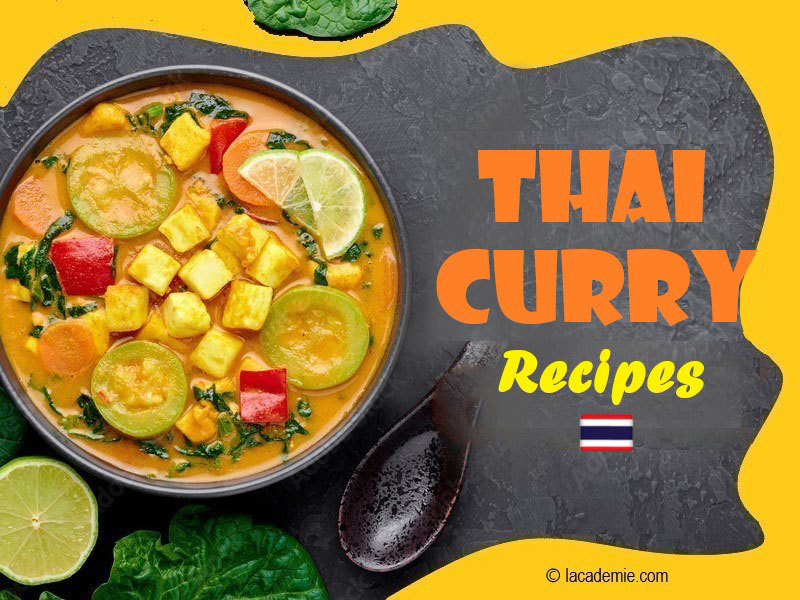
Must-Have Curry Recipes From Thai Cuisine
Indulge yourself in flavorful Thai recipes that make full use of spicy curry seasonings. Despite having an intense heat, curry always makes people come back for that addictive taste of lemongrass and shrimp paste.
1. Thai Red Curry
Total time: 30 minutes.
Despite being called red curry, the dish’s broth only has a murky orange color. Red curry is a common chicken recipe in Thailand that you will find at many street food stalls.
The color of the curry mainly comes from the Thai red paste which is made from red chili pepper, turmeric, and shrimp paste. Normally, you can easily find Thai red paste at any Asian condiments store.
To tone down the spiciness of the curry, locals usually use coconut milk to give a sweet and creamy flavor. In addition, the broth also needs some seasonings like lime juice, fish sauce, and brown sugar to create a balanced flavor.
As for the meat, my best pick is chicken tenderloin as it has a certain bounce to the meat texture. On a side note, while adding in the condiments, you need to stir the broth constantly to make sure the seasonings are dissolved evenly.
2. Thai Green Curry
Total time: 35 minutes.
The bright green color of the curry broth is attractive and otherworldly for anyone that sees this dish for the first time. However, I promise you that the curry is as creamy and delicious as other conventional recipes.
When it comes to Thai cuisine, locals get creative with the usage of various condiments to create distinct colors for every recipe. The green of the broth comes from a special green curry paste that people mainly concoct from green chilies and lemongrass.
Since many types of Thai curry paste are relatively spicy, locals often lower the spiciness by using coconut milk to make the broth. In addition, I like adding lemon zest to get a hint of freshness to the dish.
People tend to enjoy a hot bowl of green curry with a variety of vegetables like carrots, onion, and asparagus. As for the meat, I strongly recommend boneless chicken so no bone will be disrupting your eating experience.
Thai Green Curry is never this easy to make at home.
3. Thai Yellow Curry
Total time: 35 minutes.
In Thai cuisine, yellow is the most common color for many curry recipes. Although the broth tends to be murky and thick, it’s the striking bright yellow color of this popular Asian chicken recipe that attracts a lot of people’s attention.
I prefer starting my yellow curry by using coconut oil to sautee the seasoning paste. Remember, you can use any type of curry paste except the green variety to make this recipe. Then, pour in a generous amount of coconut milk to start the simmering process.
For any curry-based dish, it’s always important to have the perfect vegetables to accompany the spicy taste. In this case, you can use a combination of potatoes, carrots, and onions. To deepen the flavor, locals will utilize chicken stock for the natural chicken sweetness.
Remember, the chicken requires little time to become tenderized. That’s why you should pay attention not to overcook the chicken which may result in a loss of texture.
As a helpful tip: always use fish sauce to season your broth concoction as it helps you achieve a flavor that is close to the original recipe.
4. Vegan Coconut Curry
Total time: 30 minutes.
Don’t you just love a Thai vegetarian recipe that encompasses a variety of vegetables and possesses a super creamy flavor? Well, that’s exactly what I have to offer with this vegan coconut curry dish.
You need to get your hand on some of the finest coconut milk to make the dish. Ideally, your coconut milk should have a beautiful white color with a consistency that is similar to a thick cream. To add more flavor, I suggest using tomatoes to get a slight sourness to the base flavor.
My favorite vegetable mix is a combination of carrots, broccoli, and cauliflower. However, it’s always wise for you to put in mushrooms for that slightly chewy and crunchy texture. As for the curry flavor, any type of curry paste should work wonders with creamy coconut milk.
As a side note: If you’re on a vegan diet, then be careful while picking the curry pastes. Since many of them have shrimp paste or fish sauce as an ingredient. So your safest bet should be looking for the vegan variety of these pastes.
5. Panang Curry
Total time: 20 minutes.
Panang or Phanaeng is a type of red curry in Thailand that is characterized by a thick consistency with a hint of lime flavor. Locals usually accompany Panang with tasty rice delicacies of Thai cuisine to elevate the overall meal experience.
The consistency of Panang is one of a kind because there’s little water remaining in the broth. Instead, the Panang has a thickness that resembles sauces. Aside from the coconut milk to give a creamy flavor to Panang, people try to reduce the amount of liquid used in Panang.
Did you know that Panang has its signature paste that often appears in many Asian markets? Therefore, it’s much easier for you to get the curry paste from stores and save yourself some time since you don’t have to build the Panang flavor from the ground up.
In addition to the Panang paste, I love putting in lime leaves for a refreshing and zesty flavor. Commonly, people will use chicken breast as the main protein source for the dish. If you need to balance out the flavor, I recommend using either fish sauce or palm sugar to do so.
Panang curry is a great homemade meal for your family.
6. Thai Red Curry Noodles
Total time: 15 minutes.
Here’s a classic way that Thai people normally enjoy their curry. The addition of rice noodles to your amazing Thai red curry is a big change in terms of flavor and texture. The recipe is also a great way to renew your methods of cooking noodles.
Let’s start with the paste. My advice is to gradually dilute the spice bit by bit until it reaches the taste that you like. Remember, this recipe utilizes the curry flavor to spice up the noodles instead of making a watery dish.
Add to your concoction some condiments like fish sauce, tamarind, and coconut milk. For the noodles, my personal choice is brown rice noodles. Don’t forget that you will have to mix the noodles constantly so the curry mixture can coat evenly.
Finally, drop in some of your favorite vegetables, and your noodle dish is ready to go. You may not notice, but there’s no addition of meat to the recipe, making a perfect vegan dish as well.
7. Beef Curry
Total time: 4 – 6 hours (depending on your oven).
Beef is always a solid choice as a protein source for any recipe. In Thailand, besides using chicken in red curry, people also have a beef version. It is packed with flavorful condiments, but most importantly, anyone can follow the recipe at home.
An important note for you: not all curry paste will have the same flavor, so you need to carefully pick the condiments for the dish to retain its flavor. On the bright side, the more curry added to the mix the better the final flavor; however, you also have to be mindful of the spiciness as well.
Another option to make beef curry is to turn it into a slow cooker recipe with an Asian style to it. The beef has enough time to slowly absorb all the flavorful condiments and become tenderized at the same time. Plus, you don’t have to put tô much effort into the cooking process.
The beef plays an enormous factor in the success of the recipe. Since you will be cooking the beef for a long time, my suggestion is to pick a chunk of meat that has a nice fat to it. That way, the meat will remain tender and juicy after the cooking process.
For the base flavor, people combine coconut cream with spicy curry paste and beef bone broth. In addition, a nice splash of lime juice gives the concoction a refreshing feeling. In the end, the beef should be ultra tenderized to the point that it can melt in your mouth.
8. Vegan Thai Curry
Total time: 20 minutes.
Everyone knows that curry is considered a relatively heavy meal, but what if I can turn it into a light yet hearty recipe. If you’re having the same thoughts as me, then you should give vegan Thai curry a try.
Better yet, the dish retains its signature rich and creamy flavor of Thai cuisine. Let’s start with the stock base: you want to use yellow Thai curry paste and reduced-fat coconut milk to keep it light in the end.
The vegetable mixture is all up to your choice. But I prefer picking vegetables that have a similar cooking time so that it’s easier to work with. To compensate for the lack of meaty texture, you should use firm tofu to mix with the vegetables.
For serving, a simple but popular choice is to enjoy the flavorful vegetables on a hot bowl of rice. If you want to intensify the flavor, then sprinkling extra curry powder is not a bad choice.
9. Gaeng Pa Gai (Jungle Curry)
Total time: 50 minutes.
Gaeng Pa Gai, commonly known as Jungle curry in English, is a popular curry dish in Thailand with numerous types of vegetables. Commonly, many locals say that Gaeng Pa Gai is fiercely spicy because of the copious use of condiments.
Unlike conventional Thai curry, I want you to customize your seasoning paste for Gaeng Pa Gai. To save you some time, it’s better to use red curry paste as your base. Then, ground the paste with lemongrass, fingerroot, and chilies.
Get ready your note as the vegetable mixture is rather complicated. You will need zucchini, holy basil leaves, and long beans. In addition, people also add some toasted rice powder to impart a little nutty flavor to the dish.
Normally, Gaeng Pa Gai has a liquid broth with a light orange color from your customized paste. Locals tend to use chicken thighs for Gaeng Pa Gai because it’s an easy-to-find ingredient.
10. Vegan Green Curry
Total time: 25 minutes.
Since you’re already familiar with the green curry mentioned above, it’s super easy to make the vegan variety. Making this healthy Thai meatless recipe is a sure-fire way to impress anyone around you with your culinary skill.
Generally speaking, the green variation has a milder taste than other types of curry in Thailand. Since people create the green paste from a variety of herbs, it helps enhance the refreshing sensation of the dish.
Aside from the coconut milk and green curry paste as the base, I love adding vegetable stock to deepen the overall flavor. Most often, locals add a variety of domestic pea aubergines (often known as Turkey berry) that have a slightly bitter flavor.
In addition, you need to have tofu in the curry to get that meaty mouthfeel along with some mushrooms. Furthermore, throw in corn kernels, lime leaves, and mangetout to diversify the texture.
It’s super easy to convert a delicious Thai Green Curry recipe into a vegan version.
11. Fish Curry
Total time: 25 minutes.
It’s hard to believe that Thai cuisine possesses such an easy and cozy fish curry recipe. Like many curry dishes, this recipe represents a mildly spicy and creamy broth with a naturally sweet taste of fish meat.
For the broth, you can use any kind of curry paste that suits your taste buds, but make sure to add coconut milk to get that signature creamy flavor. If you have coconut oil and sugar, they are great additives to bring out the coconut flavor of the curry.
As for the fish, almost any type of white fish will do the job wonderfully. Different from other types of meat, fish tend to become tenderized quickly; that’s why you should check frequently. When you’re happy with the fish texture, kill off the heat and serve it hot.
12. Massaman Thai Curry
Total time: 2 hours 20 minutes.
Massaman curry has a long history that dates back to the 17th century in central Thailand when the country was still known as Ayutthaya (1351 – 1767). In my opinion, Massaman is the easiest dish for getting accustomed to endless Asian recipes or curry dishes in Thailand.
Massaman is the polar opposite of conventional curry recipes in terms of flavor. The dish doesn’t have the intense heat from the chili. People even say that the seasoning of Massaman has more similarities with that in Indian or Malaysian cuisine.
Whatever the case, Massaman curry has a thick consistency with a murky brown color. Massaman condiment paste commonly appears in Asian stores or supermarkets. Additionally, you want to add cardamom seeds, tamarind paste, and cinnamon for the Massaman base.
The beef will need some time to become tender. Don’t forget your Massaman also uses coconut milk to get the creamy flavor. Finally, you can throw in a few potato chunks to simmer with the beef.
Massaman curry is a top-notch recipe that you have to try.
13. Thai Coconut Curry Shrimp
Total time: 40 minutes.
Up to this point, I have to admit that anything tastes much better when you include curry paste into the mix. For example, you can turn any delicious Thai shrimp recipe into another notch by coating a thick layer of curry spices.
Since I’ve already mentioned coconut curry above, I’ll spare you from learning about all the ingredients of the dish. However, I strongly recommend adding a toasting step to the recipe. Toasting your condiments will help evoke more flavors from the seasoning mixture.
The shrimps are the central piece of this recipe that’s why you want to pick decent-sized ones to use for the cooking. Don’t just dump the shrimps straight into the curry; instead, you should sautee them with the spices to infuse all the aromatic goodness into the shrimps.
The result you get is juicy shrimps that are coated with creamy and rich coconut curry. My mouth is already watering just from hearing that. When serving, my go-to choice is always a hot bowl of rice to have with the shrimps.
14. Thai Red Curry Mussels
Total time: 40 minutes.
Let’s switch up the regular Thai red curry by using mussels as the main ingredient. Although it may sound strange, the result will surprise you with a tasty seafood flavor. Plus, mussels are relatively cheap and super easy to handle in cooking.
First, be sure to clean the mussel carefully because you will include the shells in your curry. If your mussels have any hair on the shell, pull it off as well. Then, prepare some ice water to keep the mussels fresh until you’re ready to steam them.
Utilize the red curry recipe that I’ve shown you above to make the base flavor. Most often, you need to steam the mussels first before transferring them into the curry. As a helpful tip: you can enhance the mussel flavor by pouring in the clam juice from the steaming process.
For a side dish, prepare a few slices of crunchy bread to accompany the flavorful mussels. People always love the slightly chewy texture of the mussels mixed with flavorful condiments.
15. Thai Monkfish Curry
Total time: 30 minutes.
I know Monkfish is not the prettiest when it comes to making it into food for human consumption. However, the fish is a delicacy in many restaurants because of its firm, lobster-like texture and a mild taste. Usually, the tail of Monkfish is the most sought-after cut of meat.
To make the curry base, you want to start sauteing chopped onion, pepper, and garlic before throwing in the green curry paste. Next, pour in the coconut milk to balance out the overall flavor. Remember to throw in additional lemongrass stalks to get a hint of citrus taste.
As for the Monkfish, you only have to cut it into bite-size cubes and cook them in the flavorful curry. On average, the fish will take around 8 – 10 minutes to fully cook. Finally, you should taste test the broth to make any adjustments in flavor with fish sauce.
Commonly, I like serving this recipe with brown rice for the additional earth and nutty flavors to accompany the Monkfish.
Amaze everyone by featuring Monkfish in your curry recipe.
16. Khua Kling (Southern Thai Dry Curry Pork)
Total time: 20 minutes.
To my surprise, Khua Kling is also a type of curry despite its dry appearance. At first glance, Khua Kling looks like a minced pork stir-fry food; however, it’s one of the cornerstones of Thai curry cuisine.
Because Thai locals don’t set any standard for the type of meat used in Khua Kling, you can even use beef or chicken to replace the pork. Additionally, locals mix diced lemon leaves and Thai chili with minced pork to cure any unwanted smell and enhance the spiciness.
The curry paste for Khua Kling is unique to Southern Thailand. It is made from shrimp paste with chili, Galangal (Southeast Asian condiment), and turmeric.
When combining the pork with the curry paste, you may find it difficult to stir-fry the mixture. But keep moving the pork around so the meat can release its moisture, making it easier to work with later on.
Khua Kling is fragrant with curry flavor that is infused into every piece of meat. Plus, the pork usually has a nice yellow color from the spices.
17. Kaeng Phed Ped Yang (Thai Red Curry With Roasted Duck)
Total time: 2 hours 25 minutes (including 2 hours of marinating).
Here’s another ingenious way for you to renew Thai red curry by swapping out the chicken for duck meat. Although the change I bring is not too big, it gives a new life to the recipe in case you get tired of chicken.
Unlike chicken meat, duck breast has a texture more akin to red meat. Therefore, I suggest marinating it in a blend of fish sauce, soy sauce, and palm sugar. Note that the duck breast needs around 2 hours to soak up all the essence of the seasoning.
For the curry, you can reuse my already listed Thai red curry recipe. Although I always prefer putting extra tomatoes and basils for an overall refreshing flavor. The creamy curry with succulent duck meat will once again spark your love for Thai cuisine.
18. Kaeng Som (Thai Southern Sour Curry)
Total time: 45 minutes.
Have you ever tasted a sour curry dish? If you’re curious, then Kaeng Som of Southern Thai cuisine is a must-try recipe in your kitchen. In Thailand, there are many variations of Kaeng Som, but the one that I feature today is based on fish as the main ingredient.
Although the Kaeng Som remains in the curry category, the broth is so liquidy that you may consider it a soup recipe from Thailand. However, the curry paste is easy to build up the flavor as it is a combination of turmeric, shallot, and bird-eye chilies.
For the soup, locals like using young papaya with a little bit of shrimp paste. The signature sourness of Kaeng Som comes from lime juice. In this case, you want to use 20 limes worth of juice.
Commonly, Thai people use any kind of saltwater fish for Kaeng Som, but my personal favorite choice is Barramundi fish. Its meat has a certain firm and moist texture, which is what I like most about the fish.
As a helpful tip: Thai locals don’t stir the curry after adding in the fish. This is to avoid the raw fish from releasing any unwanted fishy flavor. Normally, Kaeng Som mainly has a yellow-orange color from turmeric.
Discover the secret to making a perfect Kaeng Som paste right from your home.
19. Khao Soi Gai (Northern Thai Coconut Curry Noodle Soup)
Total time: 2 hours.
Khao Soi Gai is a popular curry in Northern Thai cuisine. In Thailand, people usually braise chicken in coconut milk for a long time to get a tenderized meat texture. The richness and creaminess of Khao Soi Gai are mesmerizing for anyone right on the first bite.
Most often, Northern Thai indigenous utilize Chinese egg noodles that are widely available at Asian markets for frying. Although it’s possible to use other varieties of Thai noodles, they may not produce the same crunchy texture.
Thanks to the usage of shrimp paste, Khao Soi Gai has an aromatic smell. To build up the original flavor of Khao Soi Gai, I prioritize the combination of cardamom seeds with ginger, turmeric, and lemongrass.
For the ideal experience, I always grind the ingredients to a fine paste before adding them to the broth. For the protein of Khao Soi Gai, locals resolve to chicken thighs. Finally, assemble Khao Soi Gai onto a plate and serve it hot.
20. Lamb Massaman Curry
Total time: 35 minutes.
I know regular Massaman already makes for a flavorful meal, but there’s an even better way to elevate the dish by swapping out beef for lamb. The change in meat brings a new tangy flavor with a hint of smokiness to your Massaman.
The prime feature of lamb lies in its tenderness of the meat. However, the meat can also become chewy or dry if you overcook it. After poaching the lamb, make sure you keep the water infused with lamb flavor to make the base of the Massaman curry.
Better yet, the recipe still works nicely with any left-over lamb meat from your kitchen. After adding the potatoes, it should take around 15 minutes before you continue to put in the lamb meat.
Cook the mixture for around 5 minutes, then kill the fire so that you can start serving flavorful bowls of Massaman lamb curry.
Which Thai Curry Will You Make For Your Dinner?
Don’t let the complicated condiment mixture of Thai curry deter you from making it in your kitchen. Most of the time, you will encounter many Thai seasonings always available at the supermarket.
The pre-made condiments provide you with a shortcut for a quick and heartwarming curry. So stop making bland and conventional meals; instead, bring a flavorful Thai twist to them. I just know your next meal will be a memorable one with these Thai curry recipes.
That’s all I have to offer you today. I’m always eager to read your thoughts on your latest experience with Thai cuisine and more. If you like what you’re reading, consider sharing the article with your relatives so they can know more about interesting curry dishes.
Nutrition Facts
4 servings per container
- Amount Per ServingCalories337
- % Daily Value *
- Total Fat
18.5g
28%
- Saturated Fat 13.1g 65%
- Cholesterol 46mg 16%
- Sodium 1347mg 57%
- Potassium 260mg 8%
- Total Carbohydrate
12.9g
4%
- Dietary Fiber 1.6g 4%
- Sugars 8g
- Protein 25.7g 50%
- Calcium 26%
- Iron 1%
* The % Daily Value tells you how much a nutrient in a serving of food contributes to a daily diet. 2,000 calories a day is used for general nutrition advice.
